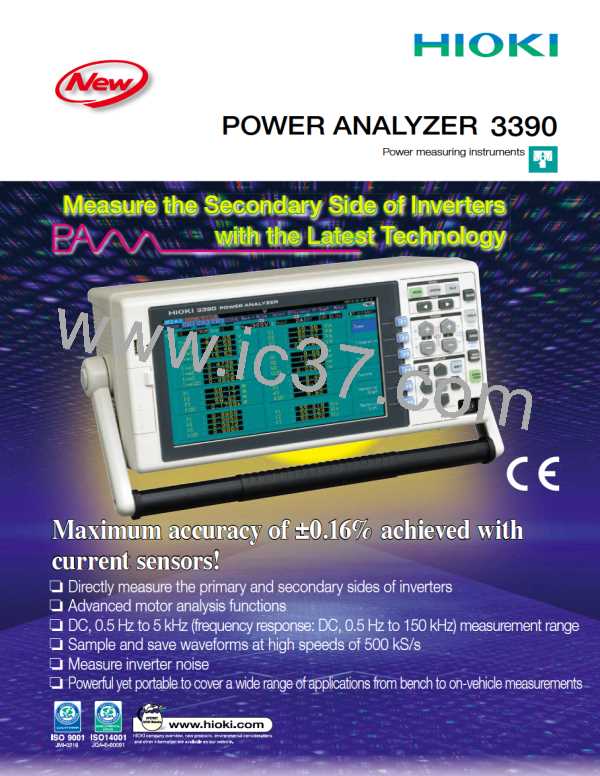2
Current Sensor Method Surpasses the Accuracy of Direct Connection Method
Power Analyzer 3390
Portable design incorporates new-generation measurement technologies
Demand for high-accuracy, wide-band, high-speed data processing with safe and simultaneous measurement over several
channels is fully met with a single unit – improving efficiency for applications to evaluate new energies, inverters and motors
3390 Power Analyzer – Your Best Partner in an Era of New Energies
■ Features
◆
Newly developed Power Analyzing Control Engine Technology processes all measurement data at
high speeds and with excellent accuracy
◆
◆
Maximum accuracy of ±0.16% (when combined with the AC/DC Current Sensor 9709)
Priimary and secondary sides of inverters can be measured simultaneously, while also measuring
inverter noise
◆
◆
Wide variety of motor evaluation and analysis functions on-board
Easy-to-read, crystal-clear, multi-colored data display on a 9” WVGA color screen
4-channel isolated input and current sensor method
Basic accuracy of Model 3390: ±0.1%
1
2
• Choose wiring from single-phase two-wire to three-phase four-wire
• Measure the primary and secondary sides of inverters simultaneously
Basic measurement range: DC, 0.5 Hz to 5 kHz
(Frequency bandwidth: DC, 0.5 Hz to 150 kHz)
Effective input range: 1% to 110%
• Synchronize the measurements of multiple
s
3390
• High accuracy, wide band, and wide dynamic range
• Also measure the secondary side of DC inverters in conjunction with a
variety of HIOKI current sensors
All data updated at 50ms*
3
•
•
Rapid processing achieved with the HIOKI proprietary Power Analyzing Control Engine Technology
50ms data refresh rate for all measurements unaffected by settings restraints
Multiple interfaces
4
• Synchronize the measurements of multiple
s
3390
• LAN and USB communication (with free dedicated software)
• Automatically save interval measurement data to a CF card
(When saving manually, measured data and waveform data can be saved directly to
the CF card and USB memory)
Automatic update rate eliminates the need of switching for low-frequency measurements
(50ms data refresh rate does not apply to waveform and noise analysis)

 ASM-SENSOR [ ASM GMBH ]
ASM-SENSOR [ ASM GMBH ]